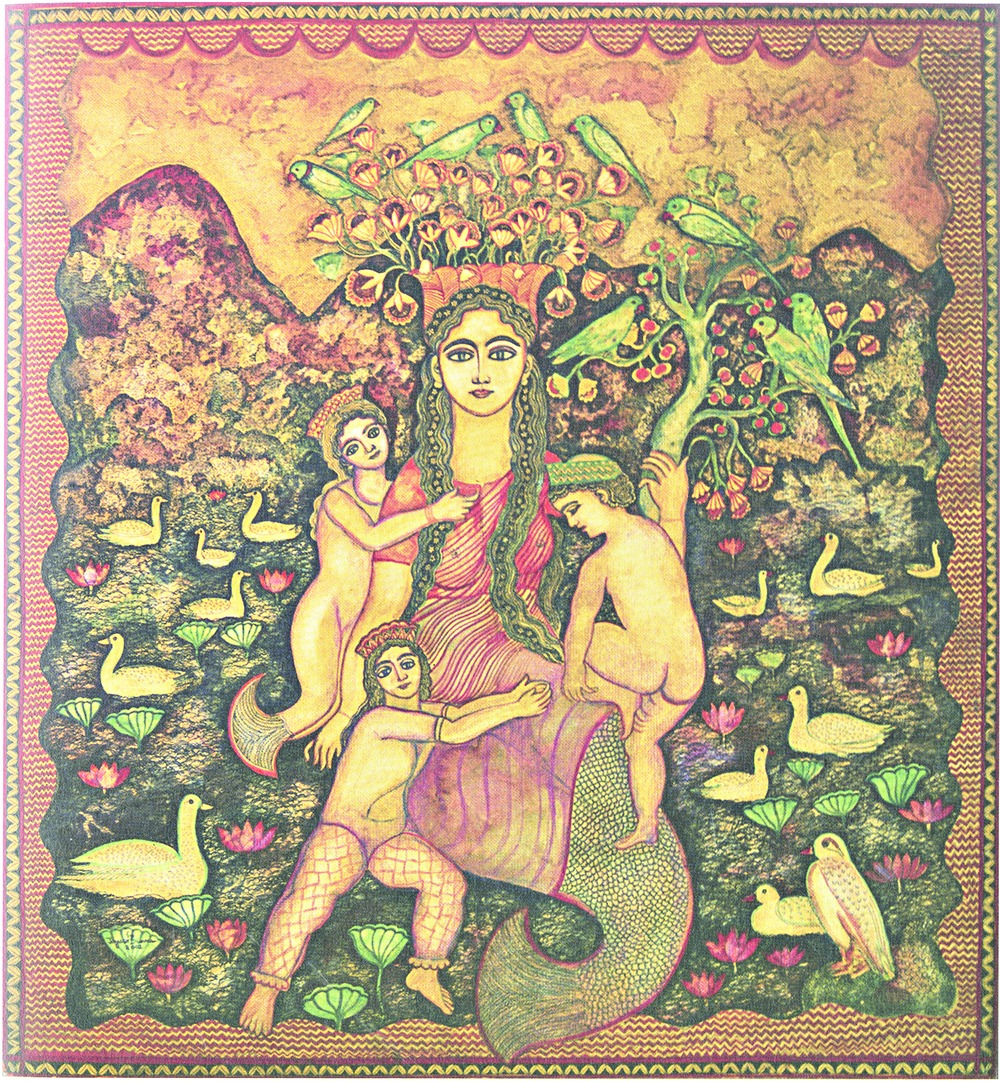
Imagine a resplendent banquet. You are seated at a massive table covered with fine white cloth. Goddess Kali is at your side, across from you is Sojourner Truth, and around you are Georgia O' Keeffe, Sacajawea, and 35 other great women from the annals of history and mythology. Exquisite, personalized table settings have been prepared for each of you in tribute to your unique contributions. "The Dinner Table", the grandly conceived artwork by Judy Chicago, stands on "The Heritage Floor". The Floor is made up of more than 2,000 white, lustre-glazed triangular tiles; each is inscribed in gold script with the name of one of 999 women who have made their mark on history.
Chicago conceived the colossal, triangular dinner table to signify Woman and Equality. Each 48-foot long side of the triangle seats 13 women to represent the number present at the Last Supper. Three historical periods are featured: women in prehistory, women from the dawn of Christianity to the Reformation, and women from the American Revolution to the feminist movement. Among those at the dinner table are Kali, Ishtar, and Sappho from the prehistoric period, Saint Bridget and Elizabeth I from Christianity to the Reformation, and Susan B. Anthony and Virginia Woolf, stalwarts of feminism.
Six heritage banners welcome the guests. A hand-painted china plate that serves as its central element highlights the place-setting for each of these remarkable women. Each woman's essential power is expressed through powerful sculptural forms that emerge from the plate. Ceramic flatware, a chalice, and a napkin with an embroidered gold edge complete each setting. The place-settings rest upon magnificently embroidered runners.
Chicago describes the Kali place- setting: "The dark lustered Kali plate includes arm-like forms that extend outward from an open and fecund core. These shapes, which are repeated in the runner, are derived from the many-armed representations of Kali in Indian art. The plate is presented on a runner created with multiple overlays of transparent materials, which extend the colors and luster of the plate into an image suggesting the awesome beauty of this dark goddess's power. In both the plate and the runner, the gaping maw and dancing fingers traditionally associated with Kali become a testament to female strength rather than a frightening presence."
A "Heritage Wall" provides a visual and written history of the 39 guests. The Dinner Party is thus a celebration of women's achievements and artistic contributions unsung by the male art canon. Women's artistry in textile, weaving, embroidery, sewing, and painting was long considered domestic art and not culturally valued as male-dominated fine art. Chicago in her wisdom has rendered these as essential features of the installation.
She used a clear set of criteria to select the women to be included in her stellar banquet. First, each woman had to have made a significant contribution to society. Chicago used feminist values to determine what counted as "significant" and consciously avoided using male yardsticks of achievement. Second, she sought to include women who had attempted to improve the conditions of other women. Third, she wanted their life's work to illuminate a significant aspect of women's history or provide a role model for a more egalitarian future.
While her initial conceptualization did not include great women beyond those who had had an impact on Western civilization, it evolved to include Kali and other Eastern goddesses who embodied the feminine principle. Kali - the mother - at once personifies civilization's most awesome, positive, and terrifying aspects. To worship her, then, is to come to terms with all aspects of humanity: giving birth, taking life, regeneration, and destruction.
Chicago undertook many years of research to determine who should be invited to her party. It took over five years to create the installation, and countless volunteers worked with her through its stormy and controversial launch. In 2007, this art work was donated as a permanent exhibit to the Brooklyn Museum. It has since become the focal point of the Center for Feminist Art, the first of its kind in the world.
Merely witnessing The Dinner Party is a thrilling and empowering experience. Judy Chicago created this icon of feminist art in 1979 to symbolize women's contributions to Western civilization from prehistoric times to the present day. The Dinner Party heralded the important contributions made by women at a time when second-wave feminists were protesting against women's erasure from history. Women yearned for images that reaffirmed them, and the show - which opened at the San Francisco Museum of Modern Art - drew huge and enthusiastic crowds in spite of its negative reviews from major art critics.
The Dinner Party has since toured 16 venues in six countries on three continents; its viewing audience now stands at over 15 million. This work could not have been created without a core group of devoted volunteers who believed in the project and its paradigm-shifting social message. The viewers' outpouring of admiration and gratitude has created a groundswell and movement to support the work. This, together with the sustained support of committed feminist patrons, overcame the near-total rejection of the installation by the male-dominated art establishment.
The Dinner Party is inspirational and a testimony to great women, their spirit of resistance, and their struggle to be heard and to have their achievements documented. It also celebrates their artistic creativity, especially in the domestic sphere, which, like so much of the rest of their work, has not been given its due.
As the world gapes in horror at the accounts of gender-based violence in an India divided along a myriad fault lines, we must seek to remedy these wrongs and celebrate India's women, its female leaders from the past, and its strong and individualistic women in the contemporary women's movement. There is no doubt that, as has been the case with Judy Chicago's dinner party, many amazing women would attend our own version of such a banquet.










